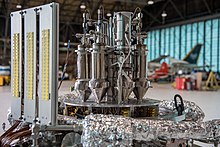Kilopower
 Prototype NASA 1kW Kilopower nuclear reactor for use in space and planet surfaces | |
| Project overview | |
|---|---|
| Formed | October 2015 |
| Parent department | NASA |
KiloPower is a NASA and Department of Energy’s National Nuclear Security Administration (NNSA) project aimed at producing a new design for nuclear reactors for space travel.[1][2] The project started in October 2015.[3] The Kilopower reactors will come in a variety of sizes able to produce from one to 10 kilowatts of electrical power, continuously for 10 years or more.[4] The fission reactor uses Uranium-235 to generate heat that is carried to the Stirling converters via passive sodium heat pipes.[5]
Testing
As of September 2017[update] a test reactor has been constructed, called KRUSTY or Kilopower Reactor Using Stirling Technology. It is designed to produce up to 1 kilowatt of electric power and is about 6.5 feet tall (1.9 meters).[6] The goal of the KRUSTY experiment is to closely match the operational parameters that would be required in NASA deep space missions[7]. The prototype Kilopower uses a solid, cast uranium-235 reactor core, about the size of a paper towel roll. Reactor heat is transferred via passive sodium heat pipes, with the heat being converted to electricity by Stirling engines. Testing to gain TRL 5 started in November 2017 and continued into 2018.[4] The first tests used a depleted uranium core manufactured by Y-12 National Security Complex in Tennessee. The depleted uranium core is exactly the same material as the regular high-enriched uranium (HEU) core with the only difference being the level of uranium enrichment[8]. The testing of KRUSTY represents the first time the United States has conducted ground tests on any space reactor since the SNAP-10A experimental reactor was tested and eventually flown in 1965[8].
During the the November 2017 through March 2018 testing of KRUSTY at Nevada National Security Site, the reactor was run successfully for 28 hours. Various faults in surrounding equipment were simulated to ensure the reactor could handle them safely. [2]
Demonstration Using Flattop Fissions
The development of KiloPower also included an experiment called DUFF or Demonstration Using Flattop Fissions experiment, which was tested in September 2012. When DUFF was tested at the Device Assembly Facility at the Nevada Test Site, it became the first Stirling engine powered by fission energy and the first use of a heat pipe to transport heat from a reactor to a power conversion system[9]. According to David Poston, the leader of the Compact Fission Reactor Design Team, and Patrick McClure, the manager for small nuclear reactor projects at Los Alamos National Laboratory[8], the DUFF experiment showed that "low-power reactor systems, nuclear testing can be accomplished with reasonable cost and schedule within the existing infrastructure and regulatory environment"[9]
See also
References
- ^ https://ntrs.nasa.gov/archive/nasa/casi.ntrs.nasa.gov/20170002010.pdf
- ^ a b Jan Wittry, Gina Anderson. "Demonstration Proves Nuclear Fission System Can Provide Space Exploration Power". NASA. Retrieved May 2, 2018.
- ^ "NASA TechPort - Public Data". Techport.nasa.gov. August 9, 2011. Retrieved February 19, 2016.
- ^ a b Loura Hall. "Powering Up NASA's Human Reach for the Red Planet". NASA.GOV. NASA. Retrieved November 15, 2017.
- ^ "Kilopower Project media slides" (PDF). NASA.GOV. NASA and Los Alamos. Retrieved January 26, 2018.
- ^ Irene Klotz (June 29, 2017). "NASA to Test Fission Power for Future Mars Colony". Space.com. Retrieved November 15, 2017.
- ^ Sanchez, Rene (March 2017). "Kilowatt Reactor Using Stirling TechnologY (KRUSTY) Experiment Update Marcy 2017" (PDF). National Criticality Experiments Research Center. Retrieved April 25, 2018.
{{cite web}}: Cite has empty unknown parameter:|dead-url=(help) - ^ a b c Gibson, Mark; Oleson, Steven; Poston, David; McClure, Patrik. "NASA's Kilopower Reactor Development and the Path to Higher Power Missions" (PDF). NASA. Retrieved March 25, 2018.
{{cite web}}: Cite has empty unknown parameter:|dead-url=(help) - ^ a b Poston, David; McClure, Patrick (January 2013). "The DUFF experiment - What was learned?". Nuclear and Emerging Technologies for Space.
External links
- Kilopower NASA web site
- KRUSTY - Kilopower Reactor Using Stirling Technology on YouTube
- Small Reactor for Deep Space Exploration - Los Alamos National Laboratory on YouTube
- Kilowatt-Class Fission Power Systems for Science and Human Precursor Missions (paper from 2013)
- KiloPower Space Reactor Concept - Reactor Materials Study
